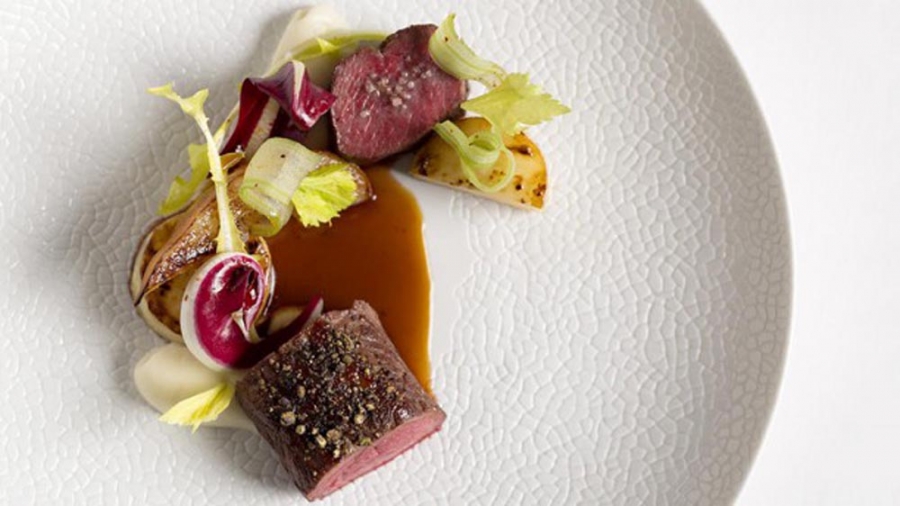The cooking of meat depends on the result we want to achieve. Some meats, such as beef tenderloin or roasts, need to be cooked aggressively (the fibers scar, thus retaining sugars), resulting in a greater nutritional and taste effect; other meats, such as muscles, jowl, and bacon, require slow cooking at a moderate temperature for the meat to be softer...
You always have to start with good quality meat, selected to get the result you want: you also have to take into account the "visual" aspects of the meat, and the fiber structure, and inquire about its origin and the type of farming. Three great French chefs share their secrets with us....
Hélène Darroze
Hélène Darroze left her native Landes region in 1999 to open her own restaurant in Paris in the 6ème arrondissement. Almost two decades have passed and she is still there, becoming one of the most highly regarded chefs in the gourmand universe, awarded a star in the Michelin Guide. But the "darling" of Parisians does not forget the simple things!
- Her method for cooking a roast: "I cook the meat slowly, at a low temperature, whether it is a veal swivel, a piece of pork or a lamb shoulder. Then I place the roast in a cocotte, browning it in a little goose fat until it reaches a light browning, and so that the juices congeal. Then I add herbs and garlic, and cook it all at 150 °C. At the end of cooking, I deglaze the preparation, thus recovering the liquid part, to make a tasty sauce. My personal trick? I add vegetables to the cocotte and cook them along with the meat (paying attention to the shorter cooking time of the vegetables)!
- Her favorite pairing? "Roast, whatever kind it is, I pair it with mashed potatoes, with plenty of butter-it's my Proust madeleine!"
- His advice? Extreme care in product selection, buying meat from a neighborhood butcher, and a preference for locally sourced meats.
Thierry Drapeau
In 2020, chef Thierry Drapeau left his native Vendée and his famous restaurant for Bangkok, where he earned a Michelin star in 2023 with his Signature restaurant. His cuisine is refined and sophisticated, yet highly emotional. A modern French cuisine, inspired by nature & the art of cooking. His creations are the result of work dictated by passion and his desire to offer the best products, bringing out all their authenticity.
- His method for preparing a fillet of duck? "I am passionate about local products, and I particularly like the canetons (ducks) of Challans. My secret for cooking the fillets is to put them in a pan, browning them - over high heat - on the skin side, until they caramelize. The important thing is to choose the duck well, buying it from a specialist retailer."
- His favorite pairing: duck with fruit (for example, pistachio and raspberries) or sweet and sour (with a chutney).
Daniel Boulud
The signature of the New York-based French chef awarded two stars in the Michelin Guide? A first-rate product, perfect cooking and a seasoning that knows how to bring out the best flavors. A concept, this, that Daniel Boulud applies in his gourmet restaurant, in his breweries, but also in preparing his burgers--the best in Manhattan, so the word on the street!
- His method for cooking a hamburger? "I use near sirloin meat or some parts of the thigh, ground to make a hamburger, as they contain enough fat (the meat must have 7 to 23 percent fat). The burger should not be too firm, and it should be 3 cm thick to be tasty and soft after cooking. Instead of a frying pan, I prefer a cast iron grill of the Le Creuset type. A secret? I do a light sprinkling of salt and pepper as soon as the burger starts to cook, and after that, I add a little cayenne pepper.
- Your advice? Heat the grill well before putting the meat on it, to speed up cooking, and never put butter or oil on the cooking grate.
What about the sauces?
As for sauces, these play a key role, related to the type of preparation. For roasts, lightly spiced sauces are perfect. For boiled meat (such as pot-au-feu [peasant boiled meat from northern France], for example) you will opt for sauces with a stronger taste (such as a sweet-and-sour mustard or a spicy horseradish sauce, for example).








